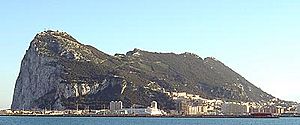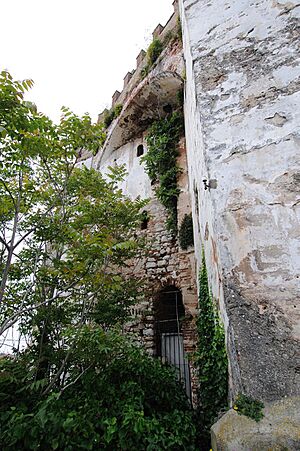First siege of Gibraltar facts for kids
Quick facts for kids First siege of Gibraltar |
|||||||
|---|---|---|---|---|---|---|---|
| Part of the Battle of the Strait during the Reconquista | |||||||
 View of Gibraltar from the West. |
|||||||
|
|||||||
| Belligerents | |||||||
| Commanders and leaders | |||||||
| Strength | |||||||
| Thousands (Unknown) | 1,200 defenders | ||||||
The First Siege of Gibraltar was an important battle during the Reconquista. The Reconquista was a long period when Christian kingdoms in Spain fought to take back land from Muslim rule. This siege happened in 1309.
In this battle, the Christian forces from the Crown of Castile fought against the Muslim forces of the Emirate of Granada. The Castilian army was led by commanders like Juan Núñez II de Lara and Alonso Pérez de Guzmán. The Granada forces were led by Sultan Muhammed III and his brother, Abu'l-Juyush Nasr.
The Castilian forces won this battle. It was one of the few successes in what was otherwise a difficult military campaign for Castile. Taking Gibraltar made Castile stronger in the Iberian Peninsula. However, Muslim forces later recaptured Gibraltar in 1333 during the third siege of Gibraltar.
Contents
Why the Siege Happened
On December 19, 1308, King Ferdinand IV of Castile made an agreement with the Crown of Aragon. This agreement was called the Treaty of Alcalá de Henares. They decided to start a war against the Emirate of Granada by June 24, 1309. This was when an earlier peace treaty between Granada and Castile was ending.
The two kingdoms agreed to work together. Aragon's king, James II, could not make a separate peace deal with Granada. They also planned to create a combined navy to block Granadian towns along the coast. Castile would attack Algeciras and Gibraltar, while Aragon would try to conquer Almería.
King Ferdinand IV promised to give Aragon some of the land they conquered from Granada. This helped Aragon become more powerful again in the Iberian Peninsula. Ferdinand wanted this alliance to make sure the Marinid dynasty (a Muslim group from North Africa) would not join the war to help Granada.
After signing the treaty, both Castile and Aragon asked Pope Clement V for his support. They wanted him to declare the war a Crusade. This would give them religious backing for their military actions. The Pope agreed. On April 24, 1309, he issued a special order called Indesinentis cure. This order allowed a general crusade against Granada.
In 1309, King Ferdinand IV announced his plan to wage war against Granada at a meeting in Madrid. He asked for money to help pay for the military operations.
Castile Prepares for War
Many important leaders and groups helped Castile prepare for the attack on Gibraltar. These included Juan Núñez II de Lara, Alonso Pérez de Guzmán, and the Archbishop of Seville. The Grand Master of the Order of Calatrava, Garci López de Padilla, also joined with his knights. Most of the army came from the city of Seville and its noble families.
To help pay for the war, Pope Clement V gave King Ferdinand IV permission to collect a special tax. On April 29, 1309, he issued another order, Prioribus decanis. This order allowed Ferdinand to collect one-tenth of all church taxes in his kingdoms for three years.
King Ferdinand IV and his army marched from Toledo to Córdoba. There, messengers from Aragon confirmed that King James II was ready to besiege Almeria. The final preparations for the siege were made in Seville, where Ferdinand IV arrived in July 1309. Supplies for the army were sent through Seville and then by sea to the areas near Granada.
The Siege of Gibraltar
After starting the siege of Algeciras, King Ferdinand IV sent part of his army to capture Gibraltar. He kept the main part of his forces around Algeciras. The group sent to Gibraltar was led by Juan Núñez II de Lara, Alonso Pérez de Guzmán, and the Archbishop of Seville. Knights from the Order of Calatrava also joined them.
Meanwhile, the forces from the Crown of Aragon, led by James II, had already begun their own attack. They started besieging the city of Almería by August 15, 1309. However, this attack did not go well. Aragon's forces had to leave Almería on January 26, 1310, because they couldn't win.
Historical records from the time of Ferdinand IV describe the siege of Gibraltar. They say that the Castilian forces surrounded the city. They used two large engeños (siege machines) to fire at the city from tall towers they built. The troops of Núñez de Lara and Alonso Pérez de Guzmán surrounded the town so completely that the Muslim defenders could not fight back effectively.
After a brave defense, the Muslim forces were forced to surrender the city. Guzmán and Lara allowed about 1,125 Muslim residents to leave Gibraltar safely.
On September 12, 1309, King Ferdinand IV's army officially took control of Gibraltar. When Ferdinand IV entered the city, an old Muslim man told him a story. The elder said he had been forced to leave three other cities by Christian kings. First, his great-grandfather, Ferdinand III, took Seville. Then, his grandfather, Alfonso X, took Xerez. Next, his father, Sancho IV, took Tarifa. Now, Ferdinand IV had taken Gibraltar. The old man said he would go across the sea to find a safe place to live out his days.
This Castilian victory ended nearly 600 years of Muslim rule over Gibraltar.
What Happened Next
After conquering Gibraltar, King Ferdinand IV ordered repairs to the city's defenses. These had been damaged during the attack. He also ordered a new tower to be built to protect the city walls. A shipyard was also built to provide a safe place for ships.
Ferdinand then returned with his army to Algeciras. However, the Castilian forces could not capture the strong fortress town there. They had to retreat, ending their campaign against Granada. This campaign was very costly for Castile. The only real success was taking Gibraltar. Castile also gained some border towns like Quesada and received a payment of 5,000 gold coins.
A Muslim historian named Ahmed Mohammed al-Maqqari also wrote about the Algeciras campaign. He said that the King of Castile, Ferdinand IV, besieged Algeciras in 1309. He stayed there for several months but could not capture it. However, he did manage to take Gibraltar.
Right after the peace treaty, the Emir of Granada, Muhammed III, faced problems. His own people were angry about the land he gave to Ferdinand IV. When he found out someone tried to kill him, Muhammed III went back to Granada. There, the people were rebelling, and his brother, Nasr Abul Geoix, had taken the throne. Muhammed III had to watch his minister be killed and his palace robbed. He soon gave up his throne to his brother.
King Ferdinand IV appointed Alfonzo Fernando de Mendoza, one of the officers from the siege, as the new governor of Gibraltar. By 1310, Ferdinand IV started a plan to repopulate Gibraltar with new settlers. He offered special rules to encourage people to move there. He also said that no taxes would be charged on goods coming in or out of the city. In February and March 1310, Ferdinand IV rewarded the city of Seville for its help in the victory at Gibraltar. He gave its people many special rights.
See also
 In Spanish: Toma de Gibraltar (1309) para niños
In Spanish: Toma de Gibraltar (1309) para niños


